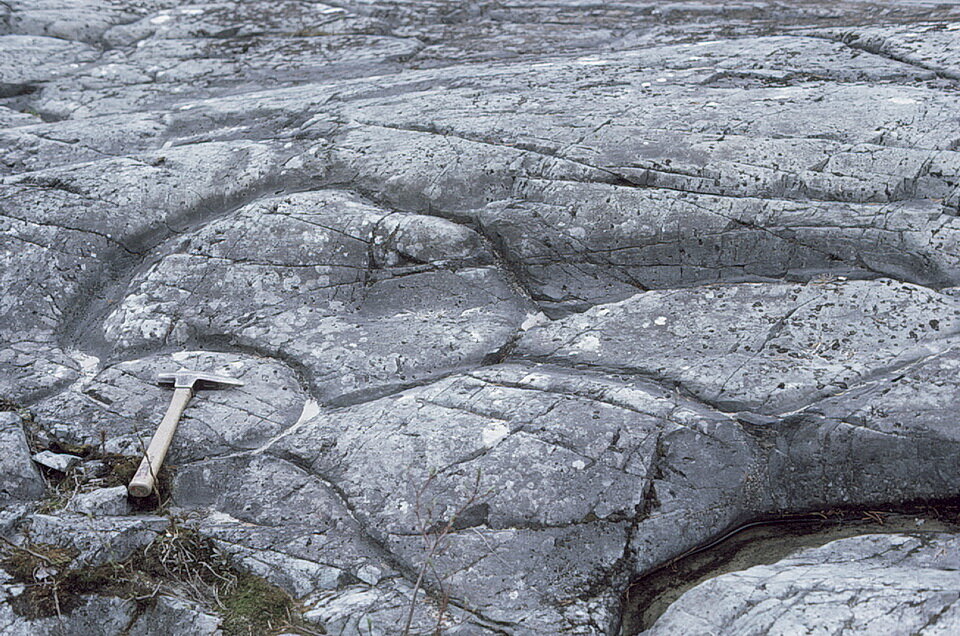The Challenge Of Identifying Geological Features By Photo
Perhaps you have heard a variation of this joke: “A geologist and an artist look at a Holstein cow. The artist says “the cow is clearly black and white”. The geologist responds “well, on that side it is”.
OK, you can substitute which ever professions you choose, but the joke serves to remind us that nature seldom offers up a unique explanation of an observation.
Identification of a geological feature from a photo can be really hard. In geology, there are generally alternative explanations for most geological observations - multiple working hypotheses. This is not the same as that political statement “alternative facts”. A fact is a fact. The cow is black and white. That is a fact, to the extent it describes “that side of the cow”.
The attached photos highlight this challenge.
Basalt Or Rhyolite
Photo 1 illustrates basalt lava that flowed over the surface of a sea floor. The bulbose features are called pillow structures - part of the evidence that lava was erupted and flowed underwater. The silica concentration of Photo 1 rock is about 50%. Geologists would not argue too much about the interpretation of Photo 1 rock.
Photo 1: Pillowed basalt. The bulbose, elliptical features outlines by a narrow, dark coloured rim, are called pillows. Pillows are like tubes, through which the lava flows. The presence of pillow features is one feature that indicated the lava flowed on a water covered surface.
Photo 2 illustrates a white, really hard rock, with bulbous features. The silica abundance of the rock is >75% SiO2 (as best I recall), similar to levels found in rocks called rhyolite. The subtle bulbous features in Photo 2 rock look like pillow structures, BUT, the rock chemistry superficially says the rock is rhyolite. It would be unusual to have a pillowed rhyolite. A paradox of sorts. I say the chemistry superficially suggests the rock is rhyolite because that is based only on silica (SiO2 abundance). It turns out there are several geochemical characteristics of the rock that tell geologists this is not a rhyolite.
Photo 2: A white, very hard rock that has a silica abundance similar to rhyolite. Yet, the bulbose features look like pillows. It would be unusual, but not impossible, to find a rhyolite with pillows. The superficial chemistry and physical features create a bit of a paradox.
Over the years, facts acquired by meticulous field mapping and advanced geochemistry resolved the paradox. Photo 2 rock actually began life as a basalt lava that flowed across the surface of an ocean floor, under water. Later in its history, Photo 2 rock was bathed in, and reacted with, hot mineralized waters (geologists call those waters hydrothermal fluids). That reaction transformed the rock from its original basalt chemistry to one having rhyolite chemistry, while preserving many of the primary features that screamed “ I am an altered basalt”.
The lesson? It can be hard to confidently offer a unique, explanation and identification of a geological feature from one or several photos, because generally, many more facts are required to eliminate the competing hypotheses - ie. to eliminate the other possible explanations.
Why Are Geologists So Cautious About Feature Identification From A Photo?
When you ask a geologist to identify a feature from a photo, you likely will hear the geologist say “well, it could be this or that”, “it is possible that it is this or that”, even if they are quite certain what the feature is. The reason? Many meticulous details are necessary to help constrain the possibilities. Likely, if you ask a geologist to identify something you photographed, they will respond with many questions to help set the context of the sample. Where did you find it? Was it along in a sea of very different material? Do you have detailed and “big picture photos”? Do you have a less fuzzy photo. Depending on the answers, the geologist may cautiously suggest some possibilities or point you to other sources of information, including a specialized expert.
Identification of a geological feature from a photo can be really hard.
Note:
My photo file labels for these photos are incomplete. I don't think I composed these photos, but I have no record who did. I am guessing that it was a Geoscientist from the Ontario Geological Survey. My apologies for not giving credit.
Andy Fyon, Sept 10, 2020.


